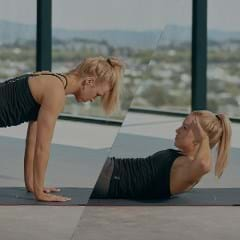If you want to take the intensity of your workout up a notch, you can’t look past the tuck jump. With just one explosive movement you can unleash a wealth of benefits:
Tuck jumps send calorie burn into overdrive
As anyone who’s performed several tuck jumps in a row will know, they are a hugely demanding exercise. The energy required not only to jump, but to pull the knees into the body, is incredibly taxing, and therefore will torch calories and burn fat fast.
Tuck jumps strengthen your core
Both the rectus abdominis and external obliques work significantly harder during tuck jumps than regular squat jumps, because the core muscles are required to generate a high level of support to lift the knees towards the chest, as well as land safely. When the core is properly engaged, the force generated from the leg muscles is transmitted to the upper body efficiently through the spine without reducing acceleration as you lift off the ground.
Tuck jumps increase athletic performance
Tuck jumps are a type of plyometric movement, which can increase the rate of muscle contraction, increase power output, enhance muscle performance and ultimately result in enhanced athletic performance. They can be especially effective for sports such as soccer and basketball.
Tuck jumps improve your strength for weightlifting
Targeting the quadriceps, glutes and hamstrings, tuck jumps are a fantastic way for Olympic weightlifters, powerlifters and athletes to develop greater power production in the lower body. The explosive nature of tuck jumps is key to helping us build strength for heavy barbell movements like deadlifts. They can also improve muscle stabilization – which is important for barbell movements.
Tuck jumps push you to the transformative HIIT training zone
A solid set of tuck jumps is one of the best ways to spike your heart rate and propel you into that magic high-intensity interval training (HIIT) training zone – where you reach 85 – 100 percent of your maximum heart rate. Including tuck jumps in a Tabata workout (a style of HIIT training where you do 20 seconds of intense exercise followed by 10 seconds rest) will help you quickly reach that transformative HIIT training zone.
How to do the perfect tuck jump
While on the outside it looks like a simple jump, there are a few tricks to perfecting your tuck jump technique.
- Start with your feet apart and your chest up
- Drop your hips back and down (similar to a half squat)
- Drive your arms up and push off the floor
- Pull your knees toward your chest
- Soften your knees and brace your core as you land to absorb the impact
How to make tuck jumps most effective
To get the most from your tuck jumps, try doing as many as you can in quick succession. Aim for 2-3 sets of 10-15 repetitions. When it gets tough, focus on your mental fortitude to push you through. If you feel like you absolutely can’t go on, simply take a short break, and then keep going – with a little practice you’ll be breezing through sets of continuous tucks in no time!
Improve your tuck jump height in six weeks
If you’re keen to improve your jumping height, there are some specific exercises that will help you raise your game. Work through these exercises twice weekly for six weeks. Make sure you stretch before you start. Do the first set at 60 percent intensity, then complete the sets as fast and explosively as possible.
Warm up: pogo stick jumps
Stand tall with your feet hip-width apart, quickly bounce up and down on the balls of your feet. Don’t let your heels touch the ground. 20-30 reps, 6 sets.
Exercise #1: Single leg hops
Stand on one leg, keeping your standing knee soft. Hop side to side. 10 on each leg, 3 sets with 120sec recovery between sets.
Exercise #2: Double leg bounds
Start with your feet hip-width apart, squat down slightly, bring your arms back behind your body, and swing them forward as you jump forward landing on both feet. 20 reps, 3 sets with 120sec recovery between sets.
Exercise #3: Pikes (with a small medicine ball thrown from your feet)
Start on your back with your legs and arms outstretched, shoulders back and down, and a small medicine ball in your hands. Engage the core and maintain control as you explosively lift your legs and arm into a V position. At the top of the movement, throw and catch the medicine ball, before lowering back down. 10 reps, 3 sets with a 90sec recovery between sets.
Exercise #4: Pike sit ups
Start on your back with your legs and arms outstretched, shoulders back and down. Engage the core and maintain control as you lift your legs and arm into a V position and then slowly lower back down. 20 reps, 2 sets with a 60sec recovery between sets.
Exercise #5: Reverse crunches
Keep your back flat on the ground, extend your legs keeping them off the ground. Focus on using your abdominals to pull your legs into crunch position and then extend them out. 20 reps, 2 sets with a 60sec recovery between sets.
Finish with maximum height jumps (1 – 3 reps)
To assess your improvement, mark the highest point you can jump tap with your fingertips on the wall. Each session re-test your height. By the end of the six weeks, you should have seen a marked improvement in your jumping height.
With no need for equipment or excessive space you can smash out sets of tuck jumps any time you please. Alternatively, give LES MILLS GRIT™ Cardio a go – it’s short, sharp high-intensity interval training (HIIT) that provides plenty of opportunity benefit from jumps, leaps, runs and more. You can also practice your tuck jumps during the athletic sports conditioning workout, BODYATTACK™, and tuck jumps make a surprise appearance in the recent BODYCOMBAT™ workouts too.








